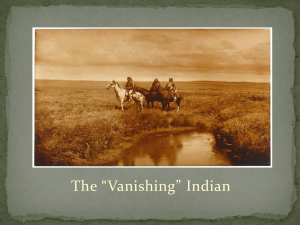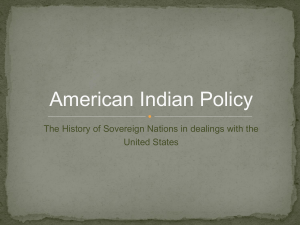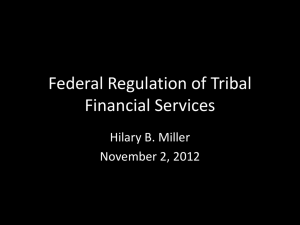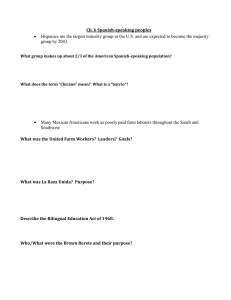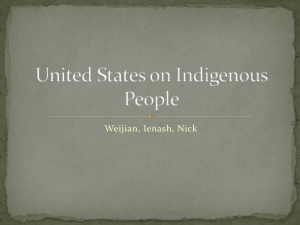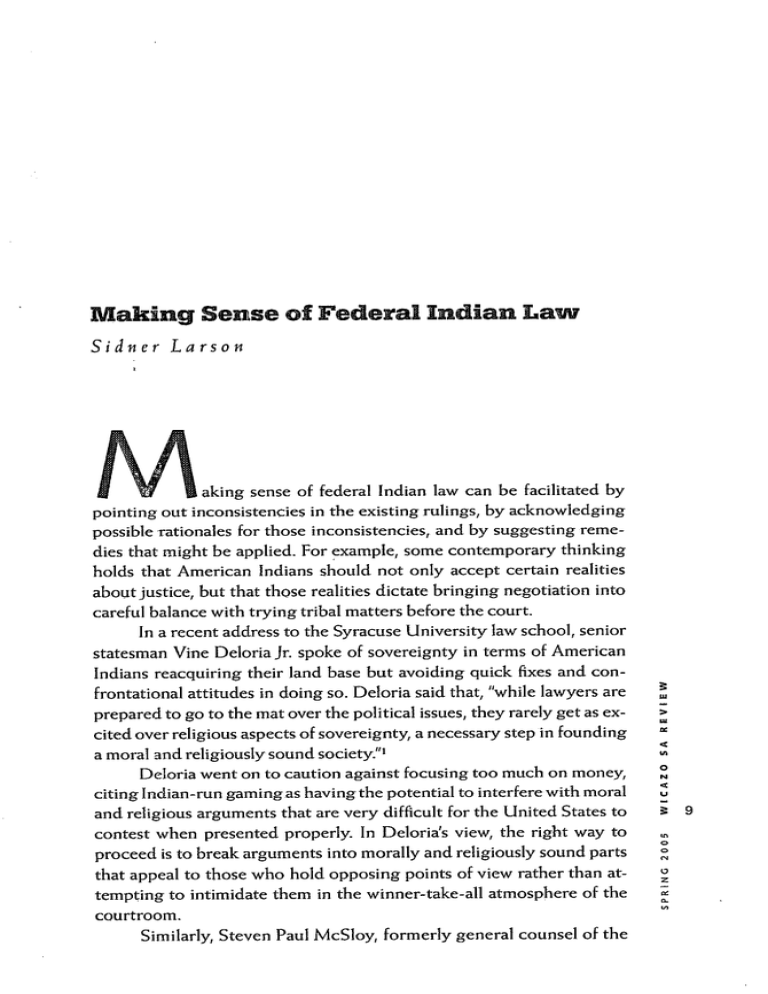
Making Sense of Federal Indian Law
Sidner Larson
sense of federal Indian law can be facilitated by
M\Aaking
pointing out inconsistencies in the existing rulings, by acknowledging
possible rationales for those inconsistencies, and by suggesting remedies that might be applied. For example, some contemporary thinking
holds that American Indians should not only accept certain realities
aboutjustice, but that those realities dictate bringing negotiation into
careful balance with trying tribal matters before the court.
In a recent address to the Syracuse University law school, senior
statesman Vine Deloria Jr. spoke of sovereignty in terms of American
Indians reacquiring their land base but avoiding quick fixes and confrontational attitudes in doing so. Deloria said that, "while lawyers are
prepared to go to the mat over the political issues, they rarely get as excited over religious aspects of sovereignty, a necessary step in founding
a moral and religiously sound society."'
Deloria went on to caution against focusing too much on money,
citing Indian-run gaming as having the potential to interfere with moral
and religious arguments that are very difficult for the United States to
contest when presented properly. In Deloria's view, the right way to
proceed is to break arguments into morally and religiously sound parts
that appeal to those who hold opposing points of view rather than attempting to intimidate them in the winner-take-all atmosphere of the
courtroom.
Similarly, Steven Paul McSloy, formerly general counsel of the
>
0
3
z
9
10
Oneida Indian Nation of New York, has advised Indians to "Stay out of
the Supreme Court. I am glad to hear about the Native Americqn.Rights
Fund's Supreme Court Project, which seeks to screen cases befR.re they
go before the Court, but to me, taking Indian cases to the.Supreme
Court has been prima facie malpractice for the last 20 years."-2W:.
McSloy uses the metaphor of the "miner's canary" to suggest that
Indians have been used to explore the uncharted territory betwegn state,
federal, executive, legislative, and judicial power. Citing the. Sppreme
Court's major Indian cases, McSloy explains how, in Cherokee Nation v.
Georgia (1831), the Court ruled in favor of the state over Indians; however,
in a similar case one year later, Worcester v. Georgia (1832), the Indians won
as a means of establishing federal supremacy over the state. In.Fx,Parte
Crow Dog (1883), the government paid legal bills to get the caswqto the
Supreme Court, where the resulting decision led to passage of thbe.Major
Crimes Act, allowing application of federal criminal law to IndiaTMi
In similar fashion, United States v. Kaganta (1886), an extesion of
Crow Dog, held that the federal government had the power to pass laws
over Indians even if such power was not authorized by the Constitution,
which made possible the General Allotment Act passed the ne-?t year;
the 1968 Indian Civil Rights Act was sponsored by North ,Carolina
senator Sam Ervin not necessarily to support Indians but to sqbgw how
tribal governments were worse violators of civil rights than.s•puthern
states; and the 1978 Indian Child Welfare Act resulted in the 1989 case
MississippiBand of Indians v. Holyfleld, where tribal jurisdiction wa5s.upheld
over that of the state. In the Strate v. A-i Contractors (1997), ýAtkjnson v.
Haldane (1977), and Nevada v. Hicks (2001) cases, however, wherg, tribal
authority was pitted against that of the federal government, allithe decisions went against the Indian parties.
n1,
With regard to Indian landclaims and in the Indian Gaming,Regulatory Act, McSloy emphasizes that Indians should stay out ppf1court,
unless, for whatever reason, the federal government is clearly,on the
Indians' side. He goes on to conclude that Indians should malke deals
instead of becoming all-or-nothing litigants, stating flatly that 'Indian
nations should get out of the sovereignty talk, get out of the rights talk,
and get out of the constitutional talk, because it is not going to work
before the current Supreme Court. Litigation is only one weapon in the
0
S
arsenal of tribal sovereignty-it should not be a tribal way of life. The
Sbest way for the canary to survive is to stay out of the mine."3
•
Various aspects of current ambivalence toward federal Indian law
can perhaps be better understood by considering the possibility that
majority domination often finds its ultimate expression in the legal sysStem, which is troubling in a very fundamental way, especially if that law
can be said to echo the colonial experience of American lndians,$
If lawyers and ultimately the Supreme Court are now in jfact the
ultimate decision makers regarding social, economic, and environmental
•t
issues, it means the least democratic branch of the American decisionmaking process has control of American society and culture. Furthermore,
if that branch's decision making is significantly biased, society and culture
cannot shift and grow, making them vulnerable to the consequences
of failing to understand the complexities of intercultural interaction.
Needless to say, such complexities are now recognized as integral to very
serious matters such as conflicts with Middle Eastern cultures.
Understanding and dealing effectively with such complexity appears increasingly subordinated to the overriding authority of lawyers
and a maelstrom of judicial freewheeling that leads in a direction that
has proven very problematic for tribal peoples. Within this paradigm
the legal system's analogical exercises seem more ad hoc than adept,
more Anglo-centric than analytical. Furthermore, it reflects a kind of
narcissism that not only controverts the values upon which this nation
was founded, but tends to affirm that the United States is yet another
colonizing entity in the violent and destructive tradition of so many
others who have gone before.
Nowhere is this more apparent than right here at home, in relations between the mainstream and American Indians, where congressional responsibility for decision making has been displaced by judicial
freewheeling that has created a form of common law that favors the
mainstream over Indians. The most obvious examples are those where
large numbers of non-Indians have managed to ensconce themselves in
Indian Country, usually motivated by profit, and where they then enjoy
overwhelming support from the mainstream legal system, which finds
ways to rule in their favor, often against both precedent and reason.
Such an assertion can be demonstrated by examples such as that of
the Ninth Circuit Court of Appeals, which has jurisdiction over the western states probably most representative of the complex notion of "Indian
Country." That court has consistently protected tribal sovereignty, from
its 1981 ruling in United States v. Montana, in which the court affirmed
tribal rights to regulate hunting and fishing on reservation fee land, to
its 2001 ruling in Atkinson Trading Co. v. Shirley, in which judges ruled that
tribes could tax non-Indian businesses on reservation fee land.
deThe United States Supreme Court, however, overturned both
cisions, in addition to many other American Indian cases decided by the
Ninth Circuit, which is a reflection of its ad hoc common law approach.
For example, it is of great concern why the Court would so consistently
ignore contrary statutory language as well as legal precedent in refusing
to allow Indian people to exercise jurisdiction over non-Indians on their
own reservations. One conclusion that can be drawn is that the problem
the Supreme Court has with Indians exercisingsuch jurisdiction is based
on negative stereotypes.
Although associating stereotypic thinking with an entity such as
the Supreme Court is troubling, precedent for such an assertion exists
0
N
•
11
in the fact that the Supreme Court affirmed establishment of concentration camps forJapanese Americans during World War 11. When one
of those Japanese Americans, Fred Korematsu, challenged that.policy,
the government defended by citing a list of racial stereotypes, including assertions that Japanese Americans were emperor worshipers who
kept to themselves in "cliquish" communities, refusing to assimilate, and
thus could not be trusted. 4
I
Whether it is true that American Indians continue to be peýrceived
to a certain degree through stereotypes, it does seem possible,there is
some basis, going back as far as the mythological sale of Manhattan for
sixteen dollars worth of beads, to say nothing of the language ound in
the first great case of U.S. Indian law, Johnson v.McIntosb:
On the discovery of this immense continent, the great nations of Europe were eager to appropriate to themselves so.
much of it as they could respectively acquire. Its vast extent offered an ample field to the ambition and enterprise.
of all; and the characterand religion of its inbabitants afforded an
apology for considering them as a people over whom the
superiorgenius of Europe migbt claim an ascendancy.5
The subsequent doctrine of discovery as well as the congressional
plenary power doctrine come from this language of Johnson v. McIntosh,
which is thought to have established the rationale for affording Indians
inferior rights because of their "character and religion."
It might also be asserted that, when the language of savagery was
eliminated during the Warren Court years, the Indians won ,.n,court.
The Rehnquist Court of the present time, however, has reintroduced
problematic language. For example, in Olipbantv. Suquamish Indign Tribe,
in 1978, the Rehnquist Court stated:
w
0
N
12
_U
B
°
The effort by Indian tribal courts to exercise criminal
jurisdiction over non- Indians... is a relatively new phenomenon. And where the effort has been made in the past,
it has been held that the jurisdiction did not exist. Until
the middle of this century, few Indian tribes maintained
any semblance of a formal court system. Offenses by one.
Indian against another were usually handled by social and
religious pressure and not by formal judicial processes;.
6
emphasis was on restitution rather than punishment.
Whether or not tribes maintained court systems in the past, theS uquamish certainly did at the time of Oliphant, which has come to •tand for
the implication that white people must be protected from Indian jurisdiction because the Indians and their systems are inferior. ,A0though
such thinking needs to be confronted, both in and out of court, Indian
court systems must also take care not to play into it as well, such as when
they seem reluctant to cooperate with mainstream legal and business
communities. As a result, it is important-that Indian people take the time
to explain ýultural traditions and the ways they do things in order to
avoid replicating the kinds of behavior they find insensitive in others.
Although understanding the role problematic thinking may have
played in allowing the Supreme Court to develop common law doctrine
is necessary, it is equally important to understand the history and evolution of that doctrine. Such comprehension begins with the fact-that, by
law, Indian tribes retain all aspects of sovereign nations except the ability
to bargain with foreign countries or to transfer lands on their own. The
tribes can bargain with the U.S. government, which they have, and they
are subject to Congress's plenary power over them, although 7it takes an
"Act of Congress" to activate that power, according to the law.
Tribal sovereignty is based on three principles: first, prior to European contact, a tribe possessed all the powers of any sovereign state;
second, European conquest terminated external powers of the tribe,
e.g., its power to enter into treaties with foreign nations, but did not
affect the internal sovereignty of the tribe, e.g., its powers to govern
itself; third, tribes retain internal sovereignty subject to treaties and by
express legislation of Congress, construed narrowly to protect tribal
8
interests and interpreted as the Indians would have understood them.
This can be confusing because it can be interpreted, from some
angles of vision, that tribal sovereignty has consistently been upheld
from the time of Worcesterv. Georgia in 1832, including Talton v. Mayes in
1896 and in Lone Wolfv. Hitchcock, where the Court also concluded that
Congress had plenary power over Indians, a power the Court deemed
9
political and not subject to control by the judicial branch of government.
In other situations, however, sovereignty has gone by the wayside.
The basic respect for tribal sovereignty reflected in the foundations of Indian law should not be overstated, however, given the fact
the tribes were not left with much over which to be sovereign at the
end of the early stages of colonization of American Indians by western
Europeans. Nevertheless, it was considered politic to advertise trust
and cooperation as the hallmarks of relations between the colonizers
and the tribes, to the point that, for years, treaties and statutes were
described as being construed narrowly to preserve tribal sovereignty
except in the case of clear statutory language or congressional intent.
Tribal sovereignty, on its face, would seem to clearly give Indians
authority over everything they have not lost due to original contact,
ceded in treaties, or lost by clear congressional action, including jurisdiction over non-Indians who enter Indian country. This has not proven to be the case, however; in fact, the Supreme Court has consistently
supported nonmember complaints over tribal authority.
0
,
U
.: 13
14
One underlying reason for this seems to be related to geographical sovereignty or the concept of "Indian Country." The concept of
Indian country, however, was developed in cases involving the tribes
and either federal or state governments, or the tribes and their own
members, but not the tribes and non-Indians. The issues related-to nonIndians in Indian country might well have been avoided had-Congress
not adopted the General Allotment Act of 1887, which divided Indian
country into allotments for tribal members, but which also opened up
the land left over to non-Indian homesteaders. Because of allotment,
much of Indian country today has a significant non-Indian population
but no truly effective means of managing the conflicts resulting from
juxtaposing radically different value systems.
Congress further complicated the concept of Indian country by
"conferring" U.S. citizenship on Indians in 1924. Citizenship was also
mandatory, however, and after that point in time Indians were not just
members of their tribes living in Indian Country, they were also citizens of both the United States and whatever state within which they
happened to be located. How, then, to maintain a geographical boundary against outsiders when Congress not only forces their entry but
forces Indians outside for further interaction?
Had a geographic boundary been possible, Indians could have
argued that the only outsider they had to deal with was Congress. Congressional policies of allotment and Indian citizenship, however, have
insured that the interests of various individuals must now be considered.
The issue of boundaries is hugely complicated by not only allotment
policy but by subsequent conflict over reservation boundaries. At the
same time, up to and including, for example, Solem v. Bartlett,10 "Indian
Country" has been understandable as encompassed by the.historic
treaty boundaries or as by later-established reservation boundaries.
Unfortunately, however, the court in Solem also vastly overcomplicated
things by adding three layers of interpretation.
The first layer of interpretation focused on vague statutory language to the effect that only clear congressional intent could diminish
SIndian interests and that Congress had not been clear in clarifying
whether allotment affected reservation borders. Second, the court
concluded that circumstances such as negotiations, legislative his0
N
tory, and the demographics of a reservation following allotment could
U
be used to infer diminishment or to shrink reservation boundaries."!
3
Third, the court concluded from reading earlier cases that the demo-
Z
graphics of a disputed reservation after allotment could be used to
show the disputed area had "lost its Indian character"12 and so it was no
longer"Indian country."
Although not the seminal case, Solem v. Bartlett is representative
of what have come to be known as diminishment cases, where Indian
lands have been diminished by subjective decisions on the part of the
Supreme Court as to whether a disputed area has lost its "Indian character." The significance of such decision making is that its subjectivity
ignores both statutory language and the clear intent of Congress, the
proper means of arriving at a decision, and relies instead on a kind of
quasi-common law approach that is, nevertheless, of its own making.
With regard to the intent of Congress, it might be said, however,
that a subsequent case, Hagen v. Utahb1 reinforced the fact that it has
tended to support assimilation of Indian lands rather than deal fairly
with Indian interests. This assertion is supported by the observation
that it is also with this case that the passage of-time begins to be recognizable as the rationale for ignoring the legal rights of Indians in their
own lands. Again, this is accomplished by a common law approach
used to observe that current demographics show non-Indians living on
those lands, patterns of governance showing that states have asserted
jurisdiction over opened lands for significant periods of time, and
that these factors "demonstrate a practical acknowledgment- that the
Reservation was diminished; a contrary conclusion would seriously dis14
rupt the justifiable expectations of [white] people living in the area."
This, unfortunately, downplays the justifiable expectations of Indian
people living in the area, even when they are the majority.
In fact, a recent diminishment case, South Dakota v. Yankton Sioux
Tribe, 15 appears to simply have abandoned canonical legal process and
capitulated to a fait accompli interpretation of the presence of nonIndians as a loss of Indian character, resulting in a privileging of the
expectations of non-Indians and reinforcing state jurisdiction. This
despite the fact that the surplus lands agreement contained a savings
clause providing that "nothing in this agreement shall be construed
to abrogate" the treaty language establishing the reservation, which
6
clause has also been ignored.1
Canonical legal process in federal Indian law means Indian lands
can be diminished only by clear congressional intent. Furthermore, the
Court insists that it has not abandoned the canonical method, and, in
a sense, it has not. To understand this, however, it is necessary to look
behind the veil of stated policy. To begin, it is necessary-to understand
and accept the fact that the American justice system is an instrument
of colonial government engaged in an ongoing displacement of indigenous peoples.
Support for this exists in the argument that, where there are
significant populations of non-Indians in Indian country, the Court
consistently favors non-Indian interests over-tribal legal autonomy and
geographical sovereignty, even going so far as to reduce geographical
sovereignty by changing reservation boundaries so that non-Indians
are free from tribal control.
The Court has also seriously undermined tribal sovereignty by
ruling that tribes have no criminal and only limited civil jurisdiction
o
N
16
_
•
Z
over nonmembers found on reservations.17 For example, cases involving
tribal authority and criminal and civil jurisdiction over non-Indians are
significantly inconsistent, with some affirming tribal authority, some
denying it, and others contradicting earlier rulings. Williams v. Lee' 8 and
United States v. Mazurie,9 are civil cases supporting tribal authority over
both Indians and non-Indians in disputes arising on reservations. Three
years after Mazurie, in Oliphant v. Suquamish Indian Tribe,20 the court held
that "Indians do not have criminal jurisdiction over non-Indians absent
affirmative delegation of such power by Congress."2' Duro v. Reina 22
subsequently held that the tribe lacked criminal jurisdiction over an
Indian who was not a member of the tribe bringing the suit.
Following its rulings precluding criminal jurisdiction, the Court
took up civil jurisdiction again in Montana v. United States,23 Brendale v.
Confederated Tribes &Bands of the Yakima Indian Nation,24 and South Dakota v.
Bourland.25 In between addressing civil jurisdiction in these three cases,
the Court had also considered tribal taxation of nonmembers in Washington v. Confederated Tribes of the Colville Indian Reservation26 and Merrion v.
27
JicarillaApache Tribe.
The results of these cases are indicative of the conflict generated
by imposing favoritism of the demographics of non-Indians -admitted
to reservations by the Allotment Act over legal precedent. For example,
by the ruling in Merrion, a tribe can tax a nonmember company where
a tribe has allowed that company on the reservation. Yet, without nonmember consent, the tribe does not have criminal jurisdictioniby the
rulings of Oliphant and Duro, cannot regulate nonmembers who hunt
or fish on nonmember fee lands unless their conduct threatens -a core
tribal interest by the ruling in Montana, might be able to zone some nonmember lands on the reservation by the ruling in Brendale, but;•cannot
even regulate the hunting or fishing of transient nonmembers opia federal recreation area within the reservation by the ruling in Bourland. On
the other hand, the tribes may require their consent for nonmembers to
enter reservation lands by the ruling in Confederated Tribes, and the tribes
shall be viewed as having the power to exclude nonmembers and other
sovereign powers unless they have explicitly waived them by the ruling
in Merrion.
.-,In yet another group of cases involving tribal attempts to regulate
nonmembers, the Court again made a significant departure from policy
that might have been established from its other rulings by reinforcing
limitations on tribal authority over nonmembers, based on what,probably could be interpreted as a continuation of the colonial experience
of American Indians. In NationalFarmersUnion Insurance Co. v. Crow Tribe,28
the Court spoke of the importance of examining legal precedent and
concluded that tribal courts were best qualified to conduct such•an examination. In Iowa Mutual Insurance Co. v.LaPlante,29 the Court reinforced
the authority of tribal courts but made vague reference to Montana,
which had held that the tribes did not have civil authority over nonIndians except in certain circumstances. The resulting confusion was
30
then addressed in Strate v. A-i Contractors, which is significant for the
ways it found to ignore both NationalFarmersand Iowa Mutual, relying on
Montana to deny tribal court jurisdiction.
3
Most recently, attention has been focused on United States v. Lara, 1
which appears to be a continuation of colonial policies directed at tribal peoples in this country. In that case Billy Jo Lara, a Turtle Mountain
Chippewa, was arrested for violation of an exclusion order by another
tribe, a tribe that happens to employ Bureau of Indian Affairs (federal)
police. During the arrest Lara struck a BIA police officer. Lara was tried
by the tribe of which he was not a member and sentenced to tribal jail
for the battery. The U.S. attorney, however, decided to file additional
federal charges for the same battery, at which point Lara claimed he
was being subjected to double jeopardy.
A number of years ago, following the Supreme Court determination in Duro v. Reina that tribes do not have jurisdiction over nonmember
Indians, Congress responded by passing an amendment to the. Indian
Civil Rights Act asserting that Congress never intended to deprive
tribes of such jurisdiction. Therefore, under the Supreme Court's 1990
determination in Duro v. Reina, Lara was subjected to double jeopardy;
however, under Congress's subsequent "Duro fix" legislation, he was not.
Lara argued that in the Duro legislation Congress gave power
to the tribes, which made his prosecution federal in essence, and thus
the second federal prosecution constituted double jeopardy. The actual language of the legislation, however, spoke to recognizing and
affirming "inherent tribal power," not delegating power to the tribes.
As a result, a reasonable interpretation is thatthe tribes and the federal
governnment are two separate sovereigns rather than one sovereign trying Lara twice. In fact, in April of 2004 the Supreme Court held, by a
vote of seven to two, that the "Duro fix" meant tribal power to try nonmembers was inherent, not delegated by the federal government, and
Mr. Lara could be prosecuted twice.The implications of the Supreme Court ruling for tribal sovereignty are considerable. First, tribes do not necessarily provide counsel
for all defendants in tribal proceedings who would be entitled to counsel in a state or federal court for the same offense. This opens the door
to subsequent challenges to tribal court proceedings based on lack of
counsel. For example, although the Court found Lara was not harmed
by lack of counsel since he was challenging the federal, not the tribal
court case, it also specifically wrote, "Other defendants in tribal proceedings remain free to raise that claim should they wish to do so!
Second, the history of Indian law includes common-law cases
decided by judges as well as federal statutes enacted under the broad
but not clearly constitutional "plenary power" of Congress. The "Duro
0
N
B 17
Z
fix" enacted by Congress, however, indicates the Supreme Court may
be entering an era of deferring to the political branches. Although this
might seem like a good thing, it is also shrouded in complexity.
For example, making Congress the final word in Indian affairs
allows Lara to go to federal prison, but, frankly, that is not what tribal
peoples want. What they do want is for the case to have ended with the
tribal court's decision and for tribal jurisdiction to be upheld on tribal
lands. Instead, Lara's defense counsel, probably unwittingly, compromised Lara's interests by compromising tribal jurisdiction. If the Supreme
Court has the last say, perhaps there is a better chance it will take responsibility for correcting the chain of bad decisions that are so detrimental
to sovereignty.
Again, although the cases cited above differ on their facts and
chronological sequence, the underlying reasoning prevails to this day,
reasoning supporting the assertion that, when Congress passed the
Allotment Act, it also precluded tribal authority over non-Indians. It is
also clear that the Court has disproportionately taken upon itself the responsibility for making and enforcing this view of congressional intent
and statutory interpretation by reaching whatever results see•m most
practical to protect non-Indian interests in various circumstances.
It has been said the problem with this approach is that it is "too
obvious a usurpation [of tribal sovereignty]." 3 2 There is also, however, a
tendency to not fully accept the inherent complexity of federal Indian
law, which has created considerable frustration: "As Justice Blackmun
noted in one case, resolving the issue there required 'wander[ing] the
maze of Indian statutes and case law tracing back 100 years.' For most
of those who follow the court, these cases were almost certainly viewed
as 'crud,' even if 'kind of fascinating,' 'peewee' cases, perhaps even
'chickenshit cases'-all epithets reportedly directed at federal,lndian
law cases by the Justices themselves when they considered petitions for
certiorari or, worse yet, when they were assigned the unenviable task of
33
drafting majority opinions for those cases."
0
N
18
V
3
Z
Part of the problem appears to be associated with an attempt to
bring constitutional protections for non-Indians into Indian Country.
This is largely a balancing act, where the Indian law cases have used
a weighing process to conclude that tribal authority over non-Indians
is prohibited for criminal jurisdiction, authorized for taxation, invalid
for civil regulation except in specified circumstances, and unsettled for
judicial jurisdiction in civil cases.
At the same time, there is a folding of federal Indian law into
general public law that not only does not fully recognize the unique
doctrines particular to a "domestic dependent nation" within the United
States but that disrupts development of a means by which this nation
might find ways to settle criminal, domestic, and environmental disputes
among various communities of difference in the new world community.
The presence of non-Indians in Indian Country has pitted genuinely unique and little-understood tribal sovereignty against what appears to be the more obvious hardship of nontribal members going
into Indian courts, possibly to face all-Indian juries. It doesn't matter
that those individuals are interlopers on reservations in the first place;
it could be that the justices identify with them more than with the
Indians and that they may have taken it upon themselves to create a
common law of colonization as a result.
The fact that tribal peoples are unique nations within the United
States appears to have been particularly problematic for the Court, and
it has been said that "states today look much more like sovereigns than
do some tribes. For example, unlike the Cherokee Nation in Worcester,
some Indian areas today have lost much of their distinctive character
and contain many non-Indian residents." For tribes to be considered
governments, or sovereigns, they must make it clear they are "a distinct
political society, separated from others, capable of managing [their]
34
own affairs and governing [themselves]." Although the means of
doing this remain unclear, recent tribal success at gaming and a revaluation of tribal values with regard to such things as environmental issues
seem very positive.
Despite the complexities involved, it still seems beneficial for
the Court to return to Congress more responsibility for balancing the
interests of Indians and non-Indians on reservations as well as establishing policy for other issues. 35 If a more careful balance could be struck,
Congress might then be better encouraged to strengthen tribal courts
in certain ways. Increased funding would, of course, be enormously
helpful, but something like a special Court of Appeals for Indian Affairs
would be a tremendous help in balancing the existing perception that
36
non-Indians cannot get a fair trial in Indian courts. Certainly Indian
lawyers should continue to coordinate with the Tribal Supreme Court
Project set up by the National Congress of American Indians and the
Native American Rights Fund (NARF) and work to make sure only
winning cases go up to the high court. The most interesting possibility,
however, and the one with the most far-reaching potential to quiet the
existing chaos in Indian Country, would be for Congress to enact an
7
"Unallotment Act." Bruce Duthu1 once discussed
a federal statute that would provide that, after the passage
of a certain amount of time, perhaps a decade, all nonmembers who remain in Indian country would be subject
to full tribal territorial sovereignty ... Congress might
provide the tribe with a right of first refusal concerning
any transfer of fee simple land within the reservation, so
that the tribe would have the privilege of purchase... A
more aggressive program would recognize a tribal power
0
N
•
Z
19
of eminent domain concerning fee simple reservation.,.
land... such efforts may have a significant chance of success on some Indian reservations today, which because of
depopulation trends by non-Indians have an increasingly
38
"Indian character."
The American legal system and its related complex of federal Indian
law have traditionally sought to position themselves as objective, authoritative, politically neutral entities standing somehow above and
outside the dynamics of living communities. The reality of the situation, however, as reflected in the present state of affairs in Indian countryM is that the law consists of all-too-human practitioners attempting
to straddle cultures that are contested, that are always in production,
where meaning is plural and always open, and where there are politics
at every turn.
What might be of more use than the unilateral creation of biased common law by the Court is a constructive conversation among
Congress, tribes, and states that includes fair and equitable consideration of nonmembers in Indian Country, even if that ultimately means
an offer to nonmembers to join in common government of an area or to
accept an offer from the tribes to sell land back to them.
Dialogue and compromise leading to pragmatic solutions such as
those described above would certainly be a vast improvement over the
doctrinal confusion and practical chaos that now exists; furthermore,
such solutions should become a priority item for unified Indian action
as soon as possible.
1 RobertJ. Taylor, "Syracuse University Hosts 'Senior Statesman'
of Native Studies," Indian Country
Today, October 8, 2003, BI.
0
2 Steven Paul McSloy, "The Role of
Jurisdiction in the Quest for Sovereignty: The 'Miner's Canary':
A Bird's Eye View of American
Indian Law and Its Future," New
EnglandLawReview 37 (2003): 738.
7 CberokeeNationv. Georgia (1831), 30
U.S. (5 Pet.) 1.
8 See Felix S. Cohen, Handbook of
FederalIndian Law (Albuquerque:
University of New Mexico Press,
1971); and, particularly, Stephen
M. Feldman, "Felix S. Cohen and
His jurisprudence: Reflections on
Federal Indian Law," Buffalo Law
Review 35 (1986): 479.
U
3 Ibid., 741.
20
0
z
4 Korematsu v. United States (1944),
323 U.S. 214.
9 Lone Wolf v. Hitcbcock (1903), 187
U.S. 553.
10 Solem v. Bartlett (1984), 465 U.S.
463.
5 Johnson v. Mclntosb (1823), 21 U.S.
(8 Wheat.) 543.
11 Ibid., 471.
6 Olipbantv. Suquatnish Indian Tribe
12 Ibid.
(1978), 435 U.S. 191.
0.
13 Hagenv. Utah (1994),510 U.S. 399.
14 Ibid., 421.
15 Soutb Dakota v. Yankton Sioux Tribe
(1998), 118 S. Ct. 789.
16 Ibid., 795.
17 Robert Laurance, "The Dominant
Society's Judicial Reluctance to
Allow Tribal Civil Law to Apply
to Non-Indians: Reservation
Diminishment, Modern Demography, and the Indian Civil Rights
Act," Universityof Richmond Law
Review 30 (1996): 781.
18 Williamsv. Lee (1959), 358 U.S. 217.
19 United States v. Mazurie (1975), 419
U.S. 544.
20 Olipbantv.Suquamisb Indian Tribe
(1978), 435 U.S. 191.
21 Ibid., 208.
22 Durov.Reina (1990), 495 U.S. 676.
23 Montanav. United States (1981), 450
U.S. 544.
24 Brendalev. Confederated Tribes &Bands
of the Yakima Indian Nation (1989),
492 U.S. 408.
25 South Dakota v. Bourland (1993),
508 U.S. 679.
26 Wasbington v. Confederated Tribes of
the ColvilleIndian Reservation (1980),
447 U.S. 134.
27 Merrionv. JicarillaApacbe Tribe
(1982), 455 U.S. 130.
28 NationalFarmersUnion InsuranceCo. v.
Crow Tribe (1985), 471 U.S. 845.
...
. .
29 Iowa Mutual Insurance Co. v. LaPlante
(1987), 480 U.S. 9.
30 Stratev. A- i Contractors (1997), 520
U.S. 538.
31
United States v.Lara (03-107) 324
F.3d 635, reversed.
32 Antonin Scalia, A Matterof Interpretation;FederalCourts and the Law,
ed. Amy Gutmann (Princeton:
University Press, 1997), 21.
33 Philip P. Frickey, "Marshalling
Past and Present: Colonialism,
Constitutionalism, and Interpretation in Federal Indian Law,"
HarvardLaw Review 107(1993):
381,422.
34 Ibid., 392,418.
35 David H. Getches, "Conquering
the Cultural Frontier, The New
Subjectivism of the Supreme
Court in Indian Law," California
LawReview 84 (1995): 1573-76.
36 See Robert N. Clinton, "Tribal
Courts and the Federal Union,"
Willamette Law Review 26 (1990):
841, 889-94.
37 N. Bruce Duthu, "Implicit Divestiture of Tribal Powers: Locating
Legitimate Sources of Authority
in Indian Country," American
Indian Law Review 19 (1994): 353,
399-400.
38 Philip P. Frickey, "A Common
Law for Our Age of Colonialism:
TheJudicial Divestiture of Indian Tribal.Authority over Nonmembers," Yale Law Journal 109
(October 1999): 1.
0
U
B: 21
0
z
COPYRIGHT INFORMATION
TITLE:
SOURCE:
PAGE(S):
WN:
Making Sense of Federal Indian Law
Wicazo Sa Review 20 no1 Spr 2005
9-21
0510511804003
The magazine publisher is the copyright holder of this article and it
is reproduced with permission. Further reproduction of this article in
violation of the copyright is prohibited. To contact the publisher:
http://www.upress.umn.edu/journals/wsr/
Copyright 1982-2007 The H.W. Wilson Company.
All rights reserved.


